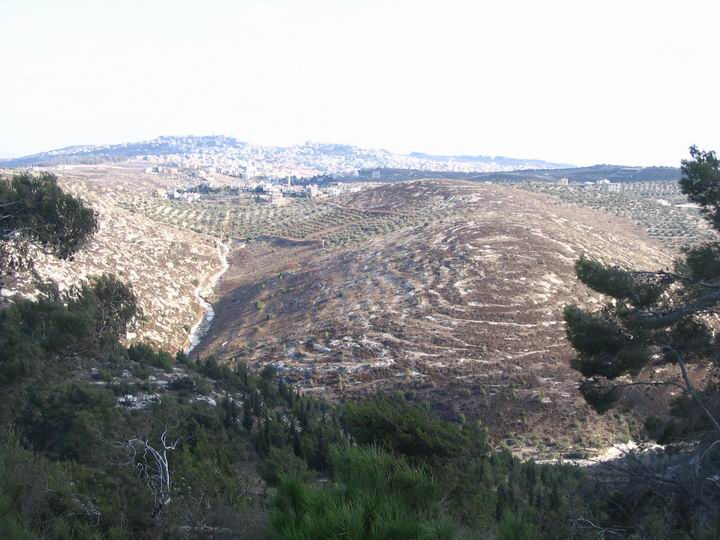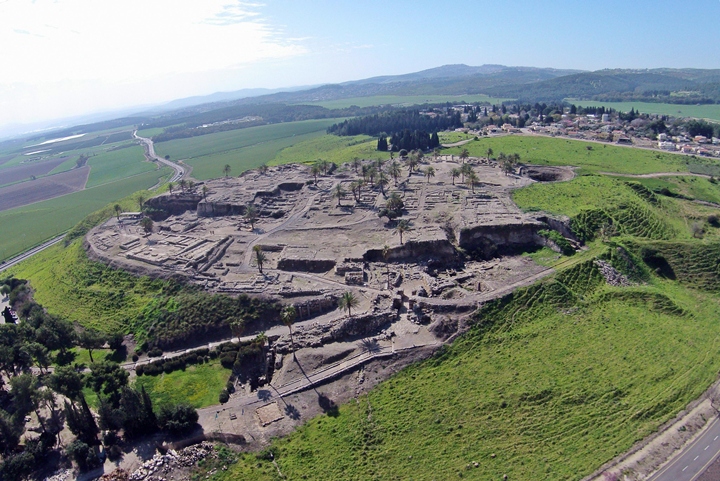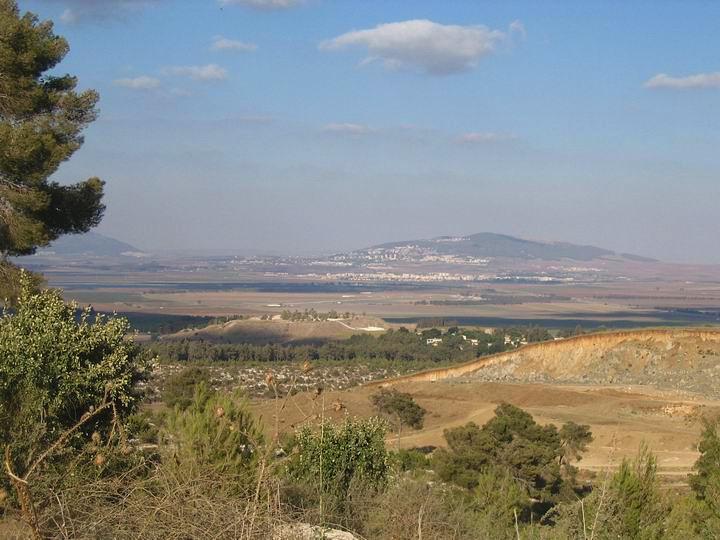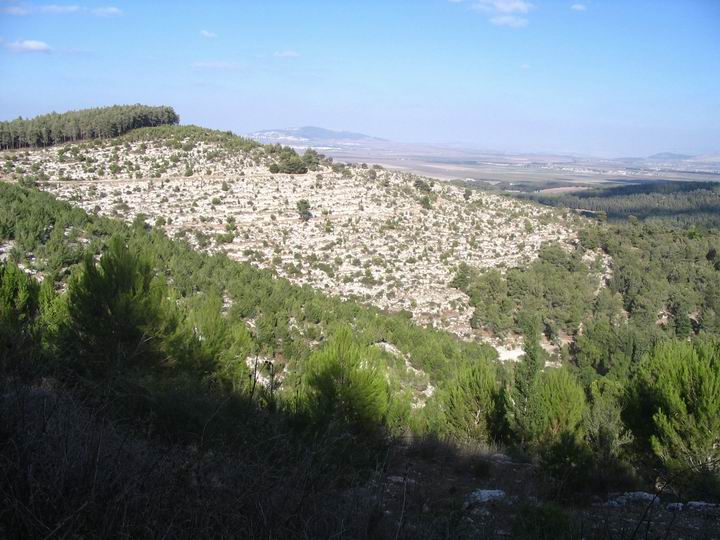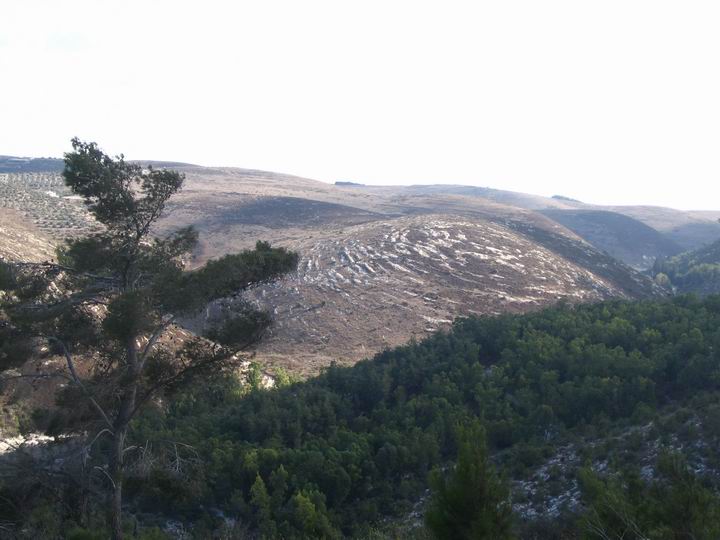This site, according to Revelation, is where the final battle will be between the forces of good and evil. The name may originate from the Hebrew name “mountain of Megiddo”.
Home > Sites > Yizreel Valley > Megiddo >Armageddon
Contents:
Background
Gog and Magog
Location
Why Megiddo?
Views
Biblical references
Etymology
Armageddon:
“Armageddon” refers to a term often associated with the end of the world or a cataclysmic event of enormous proportions. The term originates from the New Testament of the Bible, specifically from the Book of Revelation. In Revelation 16:16, it is described as the place of the final battle between the forces of good and evil during the apocalyptic events leading to the end times. “And he gathered them together into a place called in the Hebrew tongue Armageddon“.
Over time, the term “Armageddon” has been used more broadly to describe any event or situation that is perceived as leading to widespread destruction or a significant and devastating catastrophe. It is often associated with scenarios like global nuclear war, natural disasters on a planetary scale, or other apocalyptic events that could potentially lead to the end of civilization or humanity.
Pop culture has also embraced the term, and it is often used in movies, books, and other forms of entertainment to portray fictional scenarios of impending doom or large-scale disasters. One such example is the 1998 science fiction film “Armageddon,” where a group of oil drillers is sent to space to stop a massive asteroid from colliding with Earth.
It is essential to remember that while the concept of Armageddon has cultural, religious, and entertainment significance, it remains speculative and has no scientific basis or evidence. The future is uncertain, and humanity’s fate largely depends on the choices and actions we take as a species.
Battle of Gog and Magog
While distinct in Scripture, some theologians and scholars connect Armageddon with the Battle of Gog and Magog.
The concept of the Battle of Gog and Magog originates in various religious texts and traditions, primarily in the Abrahamic religions. It’s depicted as a future apocalyptic confrontation involving powerful forces that threaten to destroy humanity. Here are the main contexts in which the battle is mentioned:
1. Biblical Origins (Judaism and Christianity):
- Hebrew Bible (Old Testament): The earliest references to Gog and Magog appear in the Book of Ezekiel, specifically in chapters 38 and 39. Gog is described as the leader of a land called Magog, and they are prophesied to lead a coalition of nations against Israel in a great battle (38:2):”
Son of man, set thy face against Gog, the land of Magog, the chief prince of Meshech and Tubal, and prophesy against him…”.
- In Ezekiel, God promises to protect Israel and utterly destroy Gog and his forces.
- Christianity (New Testament): In the Book of Revelation (20:7-8), Gog and Magog are mentioned again:
“And when the thousand years are expired, Satan shall be loosed out of his prison, and shall go out to deceive the nations which are in the four quarters of the earth, Gog and Magog, to gather them together to battle: the number of whom is as the sand of the sea”.
- After a thousand-year reign of peace following the defeat of Satan, Satan is released and gathers the nations, symbolized as Gog and Magog, to wage war against God’s people. This battle ends with the defeat of Satan, Gog, and Magog, followed by the final judgment and the establishment of the new heaven and new earth.
2. Islamic Tradition:
- In Islam, Gog and Magog are known as Ya’juj and Ma’juj. They appear in the Qur’an in Surah Al-Kahf (18:83-99) and Surah Al-Anbiya (21:96-97). In these passages, they are portrayed as a corrupting force that is held back by a barrier created by a figure named Dhul-Qarnayn. In the end times, they will be released, spreading chaos and destruction across the world until they are divinely destroyed, often considered a sign of the approach of the Day of Judgment.
Themes of the Battle:
- Apocalyptic War: The battle represents a clash between good and evil, usually centered around the final days or the end times. It often symbolizes the last attempt of evil forces to dominate the earth before being ultimately defeated by God.
- Divine Intervention: In each tradition, the forces of Gog and Magog are powerful but are ultimately stopped by divine intervention, reinforcing the idea of God’s control over the world and history.
Interpretations:
- Over time, these prophecies have been interpreted symbolically, literally, or allegorically. Some view Gog and Magog as nations or powers that represent chaos and destruction, while others take a more metaphorical stance, seeing them as forces of evil that transcend specific historical or geographical locations.
- In some Christian eschatological traditions, Gog and Magog have been identified with various nations throughout history, often associated with Russia, China, or other perceived threats.
The Battle of Gog and Magog, therefore, is a powerful image of apocalyptic conflict, where divine justice triumphs over chaos and evil, marking the end of the current world order and the beginning of a new, divine reality.
Similarities Between Armageddon and Gog and Magog:
- Both involve a climactic battle between the forces of good (God) and evil (rebellious nations or satanic forces).
- Both take place in eschatological (end-time) contexts and are pivotal moments in the unfolding of God’s ultimate plan for the world.
- Both events include divine intervention, with God or Christ emerging victorious and ushering in a new, righteous era.
Key Differences:
- Timing:
- Armageddon is usually placed at the end of the Great Tribulation, just before the second coming of Christ, when the armies of the world gather against God. This leads to the establishment of God’s millennial kingdom on Earth.
- The Battle of Gog and Magog in Revelation 20 occurs after the thousand-year reign of Christ, where Satan is released for a final rebellion. The destruction of Gog and Magog in this context leads to the final judgment and the creation of a new heaven and earth.
- Participants:
- In Armageddon, the enemies are the forces of the Antichrist and the nations that align with him.
- In the Gog and Magog conflict, the enemies are symbolized by the nations of Gog and Magog, who rise up after the millennial reign. Some interpretations view these nations as representing all the rebellious peoples of the earth.
- Nature of the Battles:
- Armageddon is often depicted as a more immediate geopolitical conflict, with armies of the world gathering in a specific location (the valley of Megiddo).
- Gog and Magog are more cosmic and apocalyptic in nature, representing the final rebellion against God after the millennial peace.
Location of Har-Megiddo
The exact location of Armageddon is subject to interpretation and has been debated among Biblical scholars for centuries. Some believe it may refer to a real geographical location in the ancient world, such as the area of Megiddo in Israel. Armageddon is “in Hebrew tongue” is “Har-Megiddo”, where Har is mountain or hill, and Megiddo is the ancient site of Tel Megiddo.
Megiddo is a historical site with a long history of military conflicts and was strategically significant in ancient times. Battles fought in this region have left a lasting impact on human history, leading to the association with the term Armageddon. The ancient city of Megiddo is located 30Km south east of Haifa, and is located at a strategic entrance through the eastern Carmel/Manasseh hills where an ancient trade road (Via Maris). In this site an important City once flourished, and mentioned in the Old Testament as a strong City that played an important role in the history of the Biblical Israel.
An aerial view of Megiddo is seen here from the west side. For more information – see Tel Megiddo. The ancient mountain pass and the hills around it are on the far right background.
The hills behind the Tel (mound) are in the south, right next to the Tel. These hills can be called Har-Megeddon, the source of the name of Armageddon. The hills actually are a lower eastern extension of Mount Carmel. This section is called Manasseh mountains, and they continue on towards the great depression of the Jordan valley. This mountain ridge presented a problem in ancient times, since the passage south had to climb up the mountains. There were only few passages, and Megiddo was one of them – a sort of gate keeper.
Why Megiddo area?:
Why was the area of Megiddo selected in Revelation as the place of the future battle between the forces of Evil and forces of Good? This can be explained by the following factors:
-
The Area: Megiddo area (and the Carmel/Manasseh mountains) was a boundary between the Kingdoms of the South (Egypt) and the Kingdoms of the North (Mesopotamian Kingdoms – Assyria, Babylon, Acadian). This friction line was always a center of great battles, as echoed in the Bible.
-
Historic Battlefield: One of the earliest recorded battles occurred in the area south of Megiddo. In 1468 BC the Egyptian Pharaoh Thutmose III won a decisive battle against the revolting Canaanite cities, headed by the King of Megiddo and inspired by Egypt’s rival Mitanni (an empire based in northern Mesopotamia). After 7 more months of siege the Canaanite city of Megiddo was lost. The result was a capture of 119 cities in the land of Israel, as displayed in the Egyptian temples in Karnack. The victory over the Canaanites also resulted in the Egyptian conquest of Canaan for 350 years. The important battle echoed through the centuries, and was probably the reason this area was selected.
-
Prophecy: Prophet Zechariah was one of the twelve minor prophets in the Hebrew Bible. In the book of Zechariah he used an apocalyptic imagery to describe a future conflict between God’s people and their enemies. He describes a time when all the nations of the earth will gather against Jerusalem, but God will intervene and deliver his people. (Zechariah 14: 2,3): “For I will gather all nations against Jerusalem to battle; and the city shall be taken, … Then shall the LORD go forth, and fight against those nations, as when he fought in the day of battle”.
He also implied that the future decisive battleground in the valley near Megiddo (Zechariah 12: 9, 11):
“And it shall come to pass in that day, that I will seek to destroy all the nations that come against Jerusalem… In that day shall there be a great mourning in Jerusalem, as the mourning of Hadadrimmon in the valley of Megiddon”.
Views from the area:
A view from the Mountains of Megiddo shows the ancient Tel of Megiddo, Mount Tabor in the left background,
Har Hamoreh in the right background (with the village of Naim behind it), and the vast Jezreel valley. This valley and Megiddo has seen numerous battles in the ancient history, as described in the old Testament.
Note that the quarry in the foreground reveals a layer of volcanic rocks, sort of referring to the end of the age scene from Revelation “…and there was a great earthquake”.
Behind the quarry – Kibbutz Megiddo.
Click on the photo to view it in higher resolution…
Yet another scene of the south hills above Megiddo, seen behind the hill, from a greater distance.
A view towards the south, where the ancient road of Via Maris passes through the hills.
In the background – the Arab City of Um-El-Fakhem – which sits above the road.
Another scene of the hills of Megiddo, towards South-West.
Biblical References:
Revelation 16 : 1,2, 12-21 [KJ21]
“And I heard a great voice out of the temple saying to the seven angels, Go your ways, and pour out the vials of the wrath of God upon the earth. And the first went, and poured out his vial upon the earth; and there fell a noisome and grievous sore upon the men which had the mark of the beast, and upon them which worshipped his image.
…
And the sixth angel poured out his vial upon the great river Euphrates; and the water thereof was dried up, that the way of the kings of the east might be prepared. And I saw three unclean spirits like frogs come out of the mouth of the dragon, and out of the mouth of the beast, and out of the mouth of the false prophet. For they are the spirits of devils, working miracles, which go forth unto the kings of the earth and of the whole world, to gather them to the battle of that great day of God Almighty. Behold, I come as a thief. Blessed is he that watcheth, and keepeth his garments, lest he walk naked, and they see his shame. And he gathered them together into a place called in the Hebrew tongue Armageddon…”.
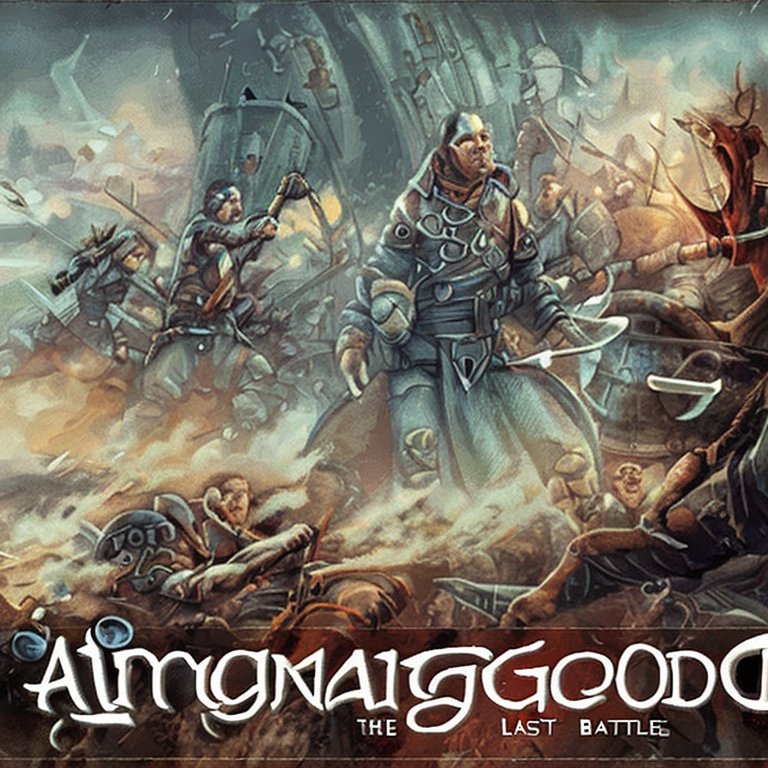
Illustration of Armageddon -the last battle – AI generated by Stable Diffusion
“And the seventh angel poured out his vial into the air; and there came a great voice out of the temple of heaven, from the throne, saying, It is done. And there were voices, and thunders, and lightnings; and there was a great earthquake, such as was not since men were upon the earth, so mighty an earthquake, and so great. And the great city was divided into three parts, and the cities of the nations fell: and great Babylon came in remembrance before God, to give unto her the cup of the wine of the fierceness of his wrath. And every island fled away, and the mountains were not found. And there fell upon men a great hail out of heaven, every stone about the weight of a talent: and men blasphemed God because of the plague of the hail; for the plague thereof was exceeding great”.
Revelation 19 : 11-21 [KJ21]
“And I saw heaven opened, and behold a white horse; and he that sat upon him was called Faithful and True, and in righteousness he doth judge and make war. His eyes were as a flame of fire, and on his head were many crowns; and he had a name written, that no man knew, but he himself. And he was clothed with a vesture dipped in blood: and his name is called The Word of God. And the armies which were in heaven followed him upon white horses, clothed in fine linen, white and clean. And out of his mouth goeth a sharp sword, that with it he should smite the nations: and he shall rule them with a rod of iron: and he treadeth the winepress of the fierceness and wrath of Almighty God. And he hath on his vesture and on his thigh a name written, KING OF KINGS, AND LORD OF LORDS.
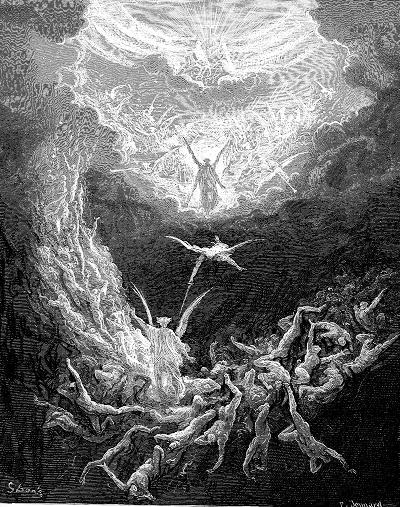
Rev 20:12 – The last judgment
– drawing by Gustav Dore (French artist, 1832-1883)
And I saw an angel standing in the sun; and he cried with a loud voice, saying to all the fowls that fly in the midst of heaven, Come and gather yourselves together unto the supper of the great God; That ye may eat the flesh of kings, and the flesh of captains, and the flesh of mighty men, and the flesh of horses, and of them that sit on them, and the flesh of all men, both free and bond, both small and great. And I saw the beast, and the kings of the earth, and their armies, gathered together to make war against him that sat on the horse, and against his army. And the beast was taken, and with him the false prophet that wrought miracles before him, with which he deceived them that had received the mark of the beast, and them that worshipped his image. These both were cast alive into a lake of fire burning with brimstone. And the remnant were slain with the sword of him that sat upon the horse, which sword proceeded out of his mouth: and all the fowls were filled with their flesh”.
Etymology (behind the name):
- Megiddo – referred in many texts in the old Testament. The source of the name is not clear. Perhaps it is based on the root G-D-D, or Gdud, meaning: battalion (a great army was stationed here), or a mound (the city was built on an impressive mound).
- Megiddon – another form of the name
- Armageddon – the nearby Mount (Har) Megiddo probably gave its name to Armageddon.
Links:
* BibleWalks pages:
- Tel Megiddo – ruins of the ancient city
- Armageddon – The ancient city behind the biblical story (BBC video, July 2023)
- Drone Aerial views – collection of Biblical sites from the air
* Other Links:
- Biblical pictures by Gustave Doré (1832-1883)
* Nov 10, 2013: Credit to Realdiscoveries.org and their readers Roger & Ian on their comments
BibleWalks.com – walk with us through the sites of the Holy Land
Megiddo <<<—previous site –<<<All Sites>>>—next lower Galilee site—>>> Tel Shimron
This page was last updated on Oct 3, 2024 (add Gog and Magog)
Sponsored links:
